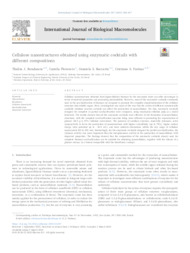Cellulose nanostructures obtained using enzymatic cocktails with different compositions.
Cellulose nanostructures obtained using enzymatic cocktails with different compositions.
Author(s): BONDANCIA, T. J.; FLORENCIO, C.; BACCARIN, G.; FARINAS, C. S.
Summary: Cellulose nanostructures obtained from lignocellulosic biomass by the enzymatic route can offer advantages in terms of material properties and processing sustainability. However, most of the enzymatic cocktails commonly used in the saccharification of biomass are designed to promote the complete depolymerization of the cellulose structure into soluble sugars. Here, investigation was made of the way that the action of different commercially available cellulase enzyme cocktails can affect the production of nanocellulose. For this, enzymatic cocktails designed for complete or partial saccharification were compared, using eucalyptus cellulose pulp as a model feedstock. The results showed that all the enzymatic cocktails were effective in the formation of nanocellulose structures, with the complete saccharification enzymes being more efficient in promoting the coproduction of glucose (36.5 g/L, 87% cellulose conversion). The presence of auxiliary enzymes, especially xylanases, acted cooperatively to favor the production of nanostructures with higher crystallinity (up to 79%), higher surface charge (zeta potential up to − 30.9 mV), and more uniform dimensions within the size range of cellulose nanocrystals (80 to 350 nm). Interestingly, for the enzymatic cocktails designed for partial saccharification, the xylanase activity was more important than the endoglucanase activity in the production of nanocellulose with improved properties. The findings showed that the composition of the enzymatic cocktails already used for complete biomass saccharification can be suitable for obtaining nanocellulose, together with the release of a glucose stream, in a format compatible with the biorefinery concept.
Publication year: 2022
Types of publication: Journal article
Unit: Embrapa Instrumentation
Keywords: Biorefinery, Cellulose nanocrystal
Observation
Some of Embrapa's publications are published as ePub files. To read them, use or download one of the following free software options to your computer or mobile device. Android: Google Play Books; IOS: iBooks; Windows and Linux: Calibre.
Access other publications
Access the Agricultural Research Database (BDPA) to consult Embrapa's full library collection and records.
Visit Embrapa Bookstore to purchase books and other publications sold by Embrapa.

